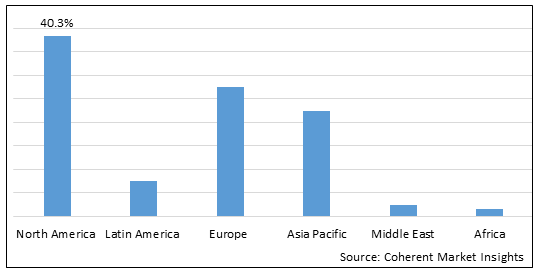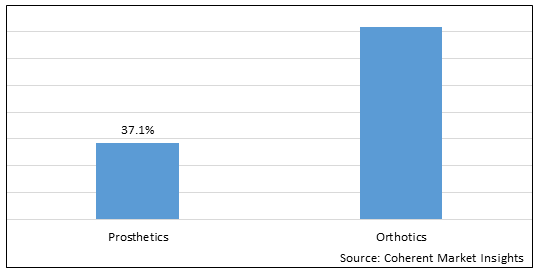
Prosthetics And Orthotics Market is estimated to be valued at USD 7,358.9 Mn in 2025 and is expected to reach USD 9,112.2 Mn in 2032, exhibiting a compound annual growth rate (CAGR) of 3.1% from 2025 to 2032. The global prosthetics and orthotics market is experiencing strong growth due to the increasing number of road accidents and growing burden of sports injuries around the world. Moreover, high demand for prosthetics and increasing demand for orthotics across the world is expected to boost the market growth. However, factors such as high cost of prosthetics and orthotics and inadequate healthcare infrastructure are expected to hamper the growth of the market.
Global Prosthetics and Orthotics Market: Regional Insights
Based on geography, the global prosthetics and orthotics market is segmented into North America, Latin America, Europe, Asia Pacific, Middle East, and Africa.
Among regions, North America is expected to gain highest share in the market during the forecast period due to the increasing incidence of osteosarcoma, increasing number of road accidents, rising burden of sports injuries, and growing burden of diabetes-related amputations in the United States. For instance, osteosarcoma is the most common type of cancer that starts in the bones. According to the American Cancer Society, each year, about 1,000 new cases of osteosarcoma are diagnosed in the U.S., of which, half of these are in children and teens. Most osteosarcomas occur in children, teens, and young adults between the ages of 10 and 30.
Asia Pacific is also expected to witness robust growth in the global prosthetics and orthotics market due to the growing geriatric population increasing incidence of sports injuries and road accidents, growing number of diabetes-related amputations, and increasing prevalence of osteosarcoma in the region. For instance, according to the Ministry of Road Transport and Highways, Government of India, every year, more than 1.5 lakh people in India dies on road, which translate, on an average, into 1130 accidents and 422 deaths every day and/or 47 accidents and 18 deaths every hour. This in turn is expected to increase demand for prosthetics and orthotics.
Figure 1. Global Prosthetics and Orthotics Market Share (%), by Region, 2025

To learn more about this report, Download Free Sample
Global Prosthetics and Orthotics Market Drivers:
Increasing number of road accidents to propel market growth
One of the key factors expected to augment growth of the global prosthetics and orthotics market during the forecast period is the increasing number of road accidents across the world. For instance, increasing number of road accidents led to a rise in the number of casualties, which in turn increase demand for prosthetics. According to the World Health Organization (WHO), road traffic injuries are the leading cause of death for children and young adults aged 5-29 years. Every year the lives of around 1.3 million people are cut short as a result of a road accidents. Over 20-50 million people suffer non-fatal injuries, with many incurring a disability as a result of their injury.
Growing burden of sports injuries to boost market growth
Another factor which is driving the growth of the prosthetics and orthotics market is the growing burden of sports injuries around the world. For instance, the increasing burden of sports injuries is also increasing the demand for prosthetics and orthotics across the globe. According to the WHO 2021 report, an estimated 305 million people across the world suffer from musculoskeletal injuries, while 222 million people suffer from neck pain. Moreover, according to the Brain Injury Research Institute, 2021 statistics, every year, more than 1.6 million-3.8 million recreation and sport-related concussions occur in the United States.
Global Prosthetics and Orthotics Market Opportunities:
Increasing demand for prosthetics worldwide is expected to offer significant growth opportunities for player in the prosthetics and orthotics market. For instance, in December 2022, NYU Langone Health completed its first set of surgeries using the only U.S. Food & Drug Administration (FDA)–approved implantable prosthetic for people with limb loss available in the greater New York City area. The procedure, known as osseointegration, seeks to improve the quality of life for individuals with limb loss by enhancing the connection between limb and prosthesis. It is a first and only FDA-approved technology for bone-anchored prostheses in the United States.
Increasing demand for orthotics is expected to offer significant growth opportunities for players in the global prosthetics and orthotics market. For instance, in November 2022, the United Nations Development Programme in Rwanda, in partnership with Swiss Limbs and Home de la Vierge des Pauvres (HVP) Gatagara, launched a 3D computer-Aided Design and Manufacturing of orthotics and prosthetics. The novel technology will help to improve the efficiency and quality of the limbs produced. The technology will improve the efficiency of the work by scanning patients effectively during consultations and using a 3D milling machine to produce the forms.
Prosthetics and Orthotics Market Report Coverage
| Report Coverage | Details | ||
|---|---|---|---|
| Base Year: | 2024 | Market Size in 2025: | USD 7,358.9 Mn |
| Historical Data for: | 2020 To 2024 | Forecast Period: | 2025 To 2032 |
| Forecast Period 2025 to 2032 CAGR: | 3.1% | 2032 Value Projection: | USD 9,112.2 Mn |
| Geographies covered: |
|
||
| Segments covered: |
|
||
| Companies covered: |
Ossur, Steeper Group, Blatchford, Inc., Fillauer LLC, Ottobock, and WillowWood Global LLC, among others. |
||
| Growth Drivers: |
|
||
| Restraints & Challenges: |
|
||
Uncover macros and micros vetted on 75+ parameters: Get instant access to report
Global Prosthetics and Orthotics Market Trends:
High demand for amputations is a recent trend
People with diabetes are at increased risk of needing lower limb amputation. Wounds and/or ulcers that do not heal are the most common cause of amputation, which in turn increase demand or need for amputations. Lower-limb amputations (LLA), which is a surgery to remove a leg, foot, or toe, are increasing in the U.S., and 80% are a result of complications from diabetes. Moreover, people who've had one amputation are at higher risk of having another. Thus, with the high prevalence of diabetes, the demand for amputations is also increasing, and this trend is expected to continue over the forecast period, driving the growth of the market.
Growing geriatric population is another trend
Geriatric patients are much more likely to have lower, than upper, limb amputations. The leading cause of LEA in patients over 65 is severe peripheral artery disease (PAD), with-without diabetes. Lower limb amputation is a frequently performed procedure in elderly people requiring extensive rehabilitation and long term care. The leading cause of LLA in patients over 65 is severe peripheral artery disease (PAD); with or without diabetes. Thus, with the growing geriatric population around the world, the demand for lower-limb amputations is also increasing. This trend is also expected to continue over the forecast period, driving the market growth.
Global Prosthetics and Orthotics Market Restraints:
High cost of prosthetics and orthotics to hinder market growth
One of the key factors expected to hamper the growth of the global prosthetics and orthotics market is the high cost of prosthetics and orthotics. For instance, price of a prosthetic leg can range from US$ 5,000 to US$ 50,000 and even the most expensive prosthetics can withstand only 3 to 5 years of wear & tear before they have to be replaced. Moreover, the cost of upper extremity devices can range from US$ 3,000 to 30,000 and these devices also have to be replaced after a certain period. They require replacement parts every year that can cost thousands more, and only a small fraction of the cost of limbs and spare parts is covered by insurance.
Inadequate healthcare infrastructure to hamper market growth
Another factor which is hampering the growth of the global prosthetics and orthotics market is the inadequate healthcare infrastructure in underdeveloped and developing countries. Prosthetics and orthotics require significant investments due to their high costs. The high cost may impede product sales, especially in underdeveloped and developing countries, where overall purchasing power of consumers is low/less. Government expenditure on healthcare is also comparatively low in these countries, which in turn hampers the adoption of these products. These factors are expected to limit the growth of the market in these countries.
Figure 2. Global Prosthetics and Orthotics Market Share (%), by Product, 2025

To learn more about this report, Download Free Sample
Global Prosthetics and Orthotics Market Segmentation:
The global prosthetics and orthotics market report is segmented into Type and Region.
Based on Type, the market is segmented into Prosthetics and Orthotics. Out of which, Prosthetics Segment is expected to dominate the prosthetics and orthotics market over the forecast period and this is attributed to the increasing demand for prosthetics.
Orthotics Segment is also expected to witness robust growth in the near future and this is owing to the increasing demand for orthotics across the globe.
Global Prosthetics and Orthotics Market: Key Developments
In December 2025, Adapttech partnered with Alfimed to distribute its prosthetic fitting solutions to the Nordic market. Adapttech’s focus is to create/develop devices that aid lower-limb amputees to improve their quality of life through innovative technologies.
In July 2021, AOPA (American Orthotics and Prosthetic Association) announced the launch of the Medicare Orthotics and Prosthetics Patient-Centered Care Act in the Senate.
In November 2021, Ottobock acquired suitX, the U.S.-based company specializing in the research and development of occupational and medical exoskeletons.
Global Prosthetics and Orthotics Market: Key Companies Insights
The global prosthetics and orthotics market is highly competitive. This is attributed to the growing demand for prosthetics and orthotics, as a result, players in the market are focusing on developing and launching novel products in the market.
Some of the key players in the global prosthetics and orthotics market are Ossur, Steeper Group, Blatchford, Inc., Fillauer LLC, Ottobock, and WillowWood Global LLC, among others.
*Definition: A prosthesis is an artificial device used to replace a missing part of the body, which may be lost through disease, trauma, or a condition present at birth. While, orthosis a device or support, especially for the foot, used to relieve or correct an orthopedic problem.
Share
Share
About Author
Komal Dighe is a Management Consultant with over 8 years of experience in market research and consulting. She excels in managing and delivering high-quality insights and solutions in Health-tech Consulting reports. Her expertise encompasses conducting both primary and secondary research, effectively addressing client requirements, and excelling in market estimation and forecast. Her comprehensive approach ensures that clients receive thorough and accurate analyses, enabling them to make informed decisions and capitalize on market opportunities.
Missing comfort of reading report in your local language? Find your preferred language :
Transform your Strategy with Exclusive Trending Reports :
Frequently Asked Questions
Select a License Type
Joining thousands of companies around the world committed to making the Excellent Business Solutions.
View All Our Clients